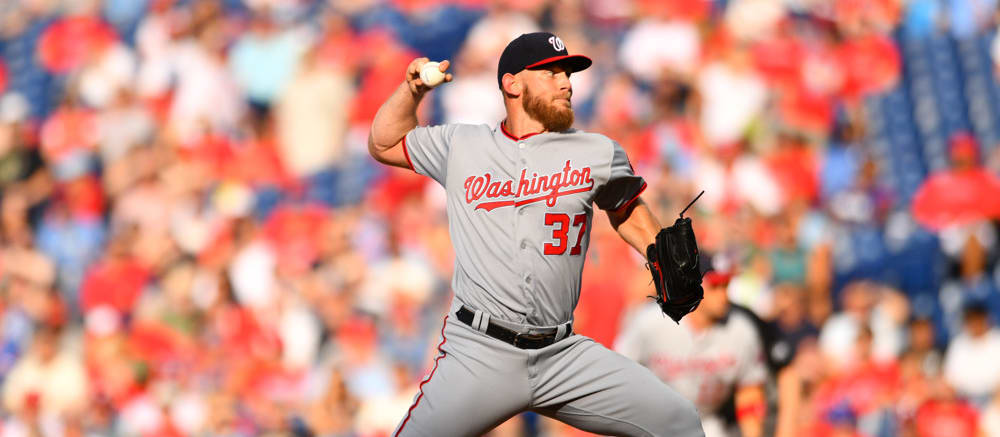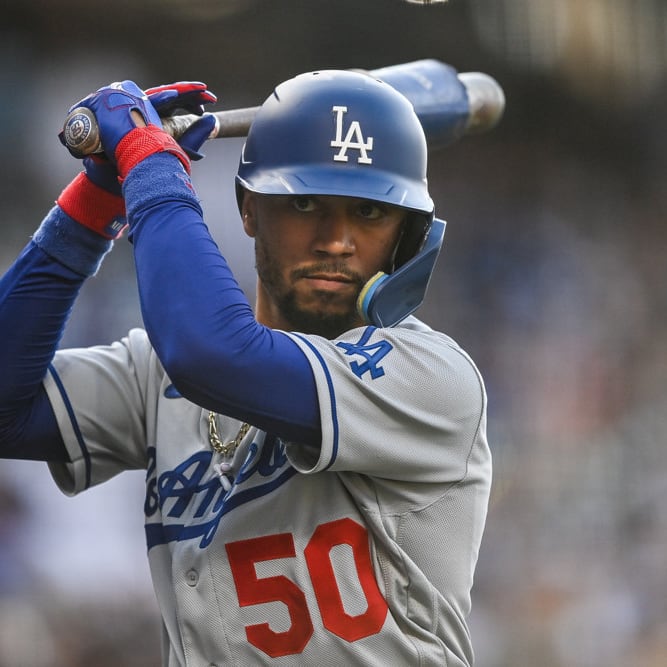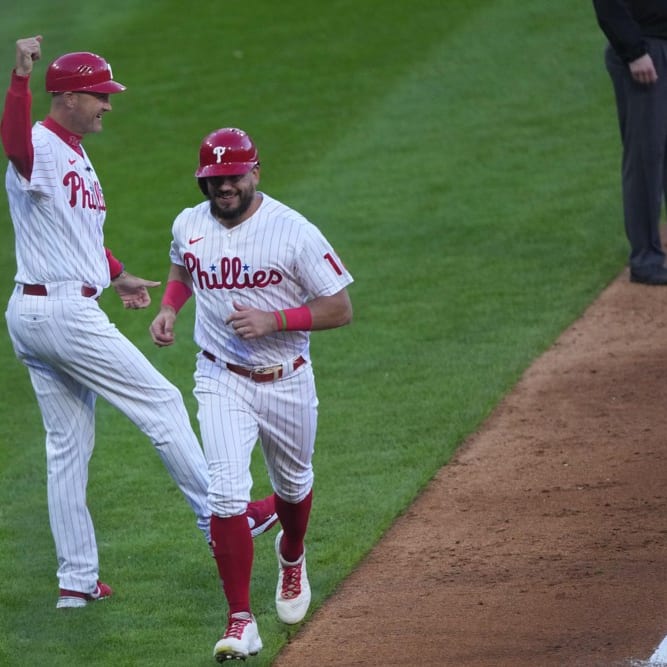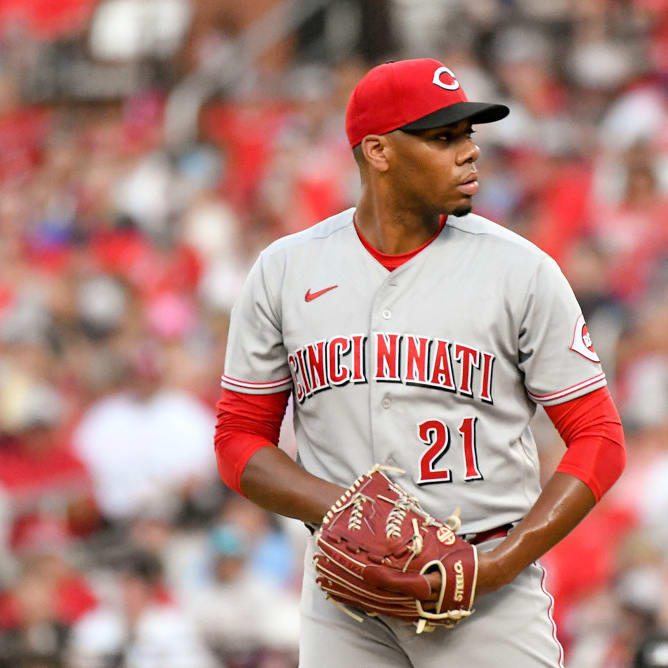This article is part of our The Z Files series.
There's been a lot of talk about the impact of a universal designated hitter, but mostly on the hitting side of the ledger. Lately however, the effect on pitchers, especially those of the Senior Circuit variety, has taken the spotlight.
There are two primary questions:
1. Are there specific hurlers earmarked for a greater of lesser adjustment relative to the average?
2. How do rankings adjust when facing a National League designated hitter is factored in?
Let's starter with the former, since it's necessary to investigate the latter. Data from the last three seasons will be considered. To be included in the study, a pitcher needed to face the equivalent of five innings against pitchers. There are 38 pitchers who satisfied that criteria each of the prior three seasons.
If it can be demonstrated individual pitchers' performance against pitchers each season is similar, then outlying 2019 numbers can be predictive of 2020 performance including a universal DH. That is, if a hurler's skills facing a pitcher were significantly better than the league average increase, he'll be hurt more by facing a designated hitter.
If it's predictive, skills derived from numbers with and without facing pitchers should be consistently better or worse than league average over the three-year span. Correlation will be used to test this, comparing 2017 to 2018, 2018 to 2019 and 2017 to 2019. If there is correlation, the results can be considered predictive. Random correlation suggests the skills exhibit variance, so trusting 2019 data in 2020 projections
There's been a lot of talk about the impact of a universal designated hitter, but mostly on the hitting side of the ledger. Lately however, the effect on pitchers, especially those of the Senior Circuit variety, has taken the spotlight.
There are two primary questions:
1. Are there specific hurlers earmarked for a greater of lesser adjustment relative to the average?
2. How do rankings adjust when facing a National League designated hitter is factored in?
Let's starter with the former, since it's necessary to investigate the latter. Data from the last three seasons will be considered. To be included in the study, a pitcher needed to face the equivalent of five innings against pitchers. There are 38 pitchers who satisfied that criteria each of the prior three seasons.
If it can be demonstrated individual pitchers' performance against pitchers each season is similar, then outlying 2019 numbers can be predictive of 2020 performance including a universal DH. That is, if a hurler's skills facing a pitcher were significantly better than the league average increase, he'll be hurt more by facing a designated hitter.
If it's predictive, skills derived from numbers with and without facing pitchers should be consistently better or worse than league average over the three-year span. Correlation will be used to test this, comparing 2017 to 2018, 2018 to 2019 and 2017 to 2019. If there is correlation, the results can be considered predictive. Random correlation suggests the skills exhibit variance, so trusting 2019 data in 2020 projections is ill advised.
Several factors were analyzed by percent difference between facing everyone and excluding pitchers: expected ERA, actual ERA, K/9, BB/9, HR/9 and Hits/9. Here are the results:
'17 to '18 | '18 to '19 | '17 to '19 | |
|---|---|---|---|
| Expected ERA | 0.33 | 0.12 | -0.02 |
| Actual ERA | -0.11 | -0.03 | -0.14 |
| K/9 | -0.27 | 0.17 | -0.09 |
| BB/9 | 0.27 | 0.17 | -0.20 |
| HR/9 | -0.06 | 0.08 | -0.01 |
| Hits/9 | 0.28 | 0.17 | -0.03 |
If you're hoping to identify specific pitchers to target or avoid, there isn't much on which to hang your hat. It's probably best to discount the 2017 to 2019 data, since more organic skills changes are more likely to have occurred over a two-year span than only one. Still, even with those changes, if data facing a pitcher were useful, it would be reflected.
It's fair to wonder if there's correlation with expected ERA (calculated using a personal method). Even if there is, it's masked in the haze of actual ERA. Still, most projections regress towards expected ERA, so it's worth further investigation.
When conducting studies of this nature, sample size is a concern. Basing a conclusion on just 38 data points is sketchy, though Bill James taught us extreme results in small samples can be real, and the above correlations are extreme. As such, in lieu of looking at individual pitchers, the yearly data will be parsed into rolling segments, with overlap at each section. The pitchers qualifying for the study each season will be sorted by K/9, BB/9, HR/9 and Hits/9. The percentage skills difference will again be the specific metric investigated.
Each season's qualified pitchers were ranked in order of the above stats. Each season was parsed into six data points with 50 percent overlap. For example, a data set of 105 would average places 1-30, 15-45, 30-60, 45-75, 60-90 and 75-105. The three seasons had a sample between 95 and 102.
As an example, the qualified pitchers were sorted by K/9. The percentage difference between overall K/9 and K/9 against non-pitchers was calculated, along with the percentage difference between ERA with and without facing pitchers. The corresponding rolling averages were determined. The data was resorted by BB/9, then HR/9, then Hits/9, for all three seasons.
I'll spare you the array of tables that mostly demonstrate a whole boatload of randomness, but there's some evidence pitchers already giving up a high number of hits will be less hurt by facing a designated hitter. Keep in mind, the data is crunched on a percentage basis, so each extra hit results in a lower percentage increase. Still, it's interesting to note there is a class of pitchers less susceptible to facing a designated hitter.
This result corroborates some recent work by colleague and the brainchild of ZIPS, Dan Szymborski, published on Fangraphs. Szymborski identified groundball pitchers as less vulnerable to extra damage via the designated hitter. Because the BABIP (batting average on balls in play) on grounders is higher than flyball BABIP, groundball pitchers tend to allow more hits anyway, consistent with the above findings.
As far as the first question posed above is concerned, the data strongly points towards lumping performance facing pitchers in with BvP (batter versus pitcher), streaks, slumps, first/second half players, clutch, etc. There are likely examples where each of the above is real. The problem is, individuals aren't identifiable.
Obviously, anyone is free to impose a narrative, self-validating why a specific batter owns a certain pitcher, is a second half hitter, or folds under pressure. In this instance, it's your prerogative to target or avoid a pitcher based on 2019's numbers against pitchers. However, the data contends you have a 50/50 shot at being right.
While it would have made great fodder to now thumbnail pitchers helped or hurt most by the universal DH, it's not happening. On the other hand, this facilitates addressing the second question above, since performance adjustments can be applied in the aggregate, thus generating adjusted pitching projections.
Please keep in mind eliminating National League pitchers from lineups is only one necessary adjustment. Once schedules and venues are clarified, those changes will need to be incorporated as well. However, that information is still unknown, so the ensuing discussion incorporates my current projections, assuming a 162-game, standard schedule. In some cases, playing time expectations need to be refined, so consider the following more of a rough illustration than something that can be used to generate a personal draft strategy.
There are a few ways to estimate the effect of National League pitchers no longer strutting to the plate. One way is to assume the numbers in the American League carry over, with the concurrent premise National League designated hitters will produce similarly to their American League counterparts. The Junior Circuit isn't setting the bar very high (.252/.339/.467 last season), so it's plausible. Another is to use the difference in performance between National League pitchers when they do and don't face pitchers. The reason I have elected to use this pathway is that stripping out the designated hitters from the American League and pitchers hitting from the National League renders stronger National League lineups. That is, if the National League designated hitters match their cross-league brethren, more runs will be scored by the Senior Circuit. This method isn't perfect, as it presumes the National League designated hitters will perform as average hitters, but that's not implausible.
For what it's worth, American League pitchers also take a hit, as they're now likely facing more National League lineups, which in the aggregate are superior to what they would have faced during interleague play in a standard season. Under the proposed 82-game schedule, each team would play 30 interleague contests, a much higher proportion than in the standard 162-game schedule.
With that as a backdrop, here are my personal adjusted rankings for a 15-team mixed league. Again, they're subject to change once the official 2020 plan is announced and differ from the site's rankings.
It's important to remember the performance delta between players is greatest at the top. In terms of expected earnings, a $4 or $5 difference results in just a spot or two drop at the top of the rankings, around 10 spots for those in the 25-35 range, growing to 15 and then 20 places later on.
None of this is perfect. We have no idea how the National League designated hitters will perform. Furthermore, all the data analyzed includes the usual strategy of working around the lower part of the order to get to the pitcher, which won't be happening. Still, there's ample information to gauge the effect of the universal designated hitters on pitching rankings, and in some cases it's significant. Upper and mid-range American League starters are far more desirable than in previous seasons, as evidenced by this table showing how many AL pitchers are included in each group:
| SP Rank | NEW | OLD |
|---|---|---|
| 1-30 | 19 | 13 |
| 31-60 | 17 | 14 |
| 61-90 | 14 | 16 |
| Total | 50 | 43 |










